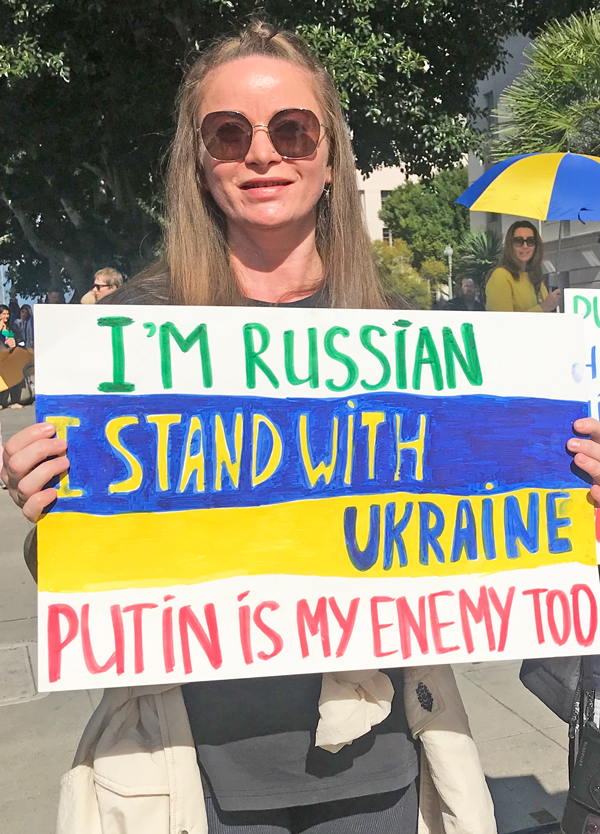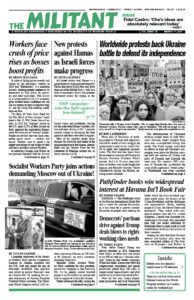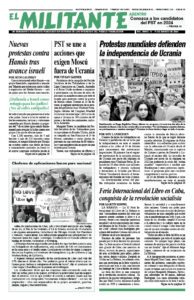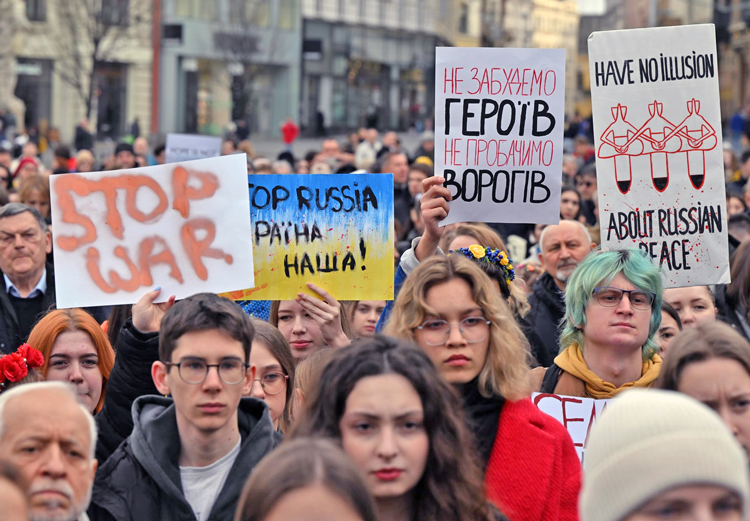Many tens of thousands of working people in Ukraine and supporters around the world of their struggle for independence took to the streets Feb. 24 to mark two important anniversaries. The first was two years since the murderous invasion of Ukraine by Russian President Vladimir Putin’s regime. And it is 10 years since millions of workers and youth fought and toppled pro-Moscow dictator Viktor Yanukovych during the Maidan uprising across Ukraine.
The determination of Ukrainian working people today to fight Moscow’s invasion draws strength from what was accomplished during that revolt. The Putin regime intensified its efforts to wipe out Ukraine’s sovereignty ever since the Maidan, starting with the seizure of Crimea and parts of Donetsk and Luhansk the same year. His regime’s 2022 invasion of Ukraine has accelerated the crisis of the imperialist “world order,” as Washington and other capitalist governments prepare for increased competition and new wars.
The Feb. 24 demonstrations in support of Ukraine’s fight to defend its independence, including by significant numbers of Russians in exile opposed to the war, took place in 746 cities in 69 countries. From Berlin to Stockholm, Chicago to Warsaw, Poland, tens of thousands turned out.

A week after Moscow’s 2022 invasion, “a statement by Socialist Workers Party National Secretary Jack Barnes hailed the courageous Ukrainian resistance and called for the defeat of Putin’s invading forces,” John Studer, the SWP national campaign director, told the Militant Feb. 27. “Our party stands on our communist continuity with V.I. Lenin’s proletarian course of defending national self-determination, including for Ukraine, as part of the 1917 socialist revolution across Russia and the former czarist prison house of nations,” Studer said.
The SWP’s statement explains that Washington and its allies “shed crocodile tears over Ukraine’s national sovereignty and the plight of its people. High-flown phrases aside, their only real concern is to protect their own profits and strategic political interests.” That remains true of President Joseph Biden’s administration today.
Alongside demonstrations marking the war’s second anniversary, an international solidarity conference at the House of Trade Unions in Kyiv was organized Feb. 22 by the Confederation of Free Trade Unions of Ukraine (KVPU) and the Federation of Trade Unions of Ukraine (FPU). Several top international union figures participated. Because of the challenges of traveling to Kyiv today most of the delegations joined by teleconference.
The two Ukrainian union federations made a joint appeal for labor solidarity. They said the Putin regime’s drive for territorial expansion is “an attempt to revive the ‘Russian Empire’” that has “turned into the largest war in Europe since the Second World War.”
Hryhoriy Osovy, president of the FPU, described the war’s devastating toll, including the deaths of thousands of civilians, the loss of 5 million jobs and the millions forced to flee their homes. Many more now live under Moscow’s occupation. He said Ukraine’s population has gone from 42 million to 27 million since Russia’s invasion.
Compounding the effects of the war has been the anti-union drive by Ukrainian bosses, backed by the government of President Volodymyr Zelensky, that has erased many protections of workers’ rights and conditions. The membership of the FPU has been reduced by 50%.
The joint KVPU/FPU appeal notes the invasion was a continuation of the Kremlin’s use of its troops based in Crimea to seize the peninsula in February 2014 from Ukraine. This was met by mass protests by Crimean Tatars. Putin then sent troops disguised as Ukrainian separatists to occupy parts of the Donbas in eastern Ukraine.
Putin claims, “Ukraine is an artificial state,” which should be part of Russia. But Ukraine’s people know otherwise, showing determination to defend its independence and refute Putin’s lies, despite all obstacles. Coming after centuries of struggle against Moscow’s domination, their resistance has won the support of millions across the world.
Kryvyi Rih, a city at the heart of Ukraine’s iron ore and steel industry, not far from the frontlines, is under constant bombardment.
Yuriy, whose apartment there was hit by a Russian missile last year, told the BBC he questioned the reason for the war.
But when asked if he thinks Ukraine’s government should swap territory for peace, he replied: “Definitely not. A lot of people died for those territories. There is no point in giving them up.”
Valeriy, in his 80s, told the BBC, “We must fight; we won’t tolerate anything else. People are so angry now.”
Andriy Kuprianov, a sergeant in the Ukrainian army who fought in Avdiivka, told the Wall Street Journal, “We’ll fight as long as it takes. Two more years, or 20 more. We’ll keep going because we know the price of failing to do so.”
The 600-mile frontline in eastern Ukraine hasn’t changed much over the past year. President Zelensky said Feb. 25 that 31,000 Ukrainian soldiers have died in two years of war.
Moscow: huge losses
The Kremlin hides the staggering scale of its losses among troops it treats as cannon fodder. The dead and severely wounded are put at a third of a million.
Though ethnic Russians comprise the majority of these deaths in absolute terms, Russia’s non-Slavic minorities and indigenous peoples suffer disproportionate casualties. Buryats, a Mongolic ethnic group native to southeastern Siberia, have a casualty rate almost four times their proportion of the population.
![Artist Elena Osipova protests Feb. 24 in St. Petersburg, Russia, with a painting in memory of Alexei Navalny, outspoken critic of Putin and his Ukraine invasion, killed Feb. 16 in Arctic prison. Under Navalny’s image and name it reads “Stop Putin’s [special military] operations.”](https://themilitant.com/wp-content/uploads/2024/03/St.-Petersburg-protest-8810.jpg)
Avdiivka is the Kremlin’s first gain since the capture of Bakhmut, last May.
“For the ruins of Avdiivka, Russia paid with more military lives than the Soviet Union did in 10 years of war in Afghanistan,” Ukrainian Minister of Foreign Affairs Dmytro Kuleba said Feb. 23.
These losses, five times greater than Ukraine’s, are causing sharp discord within the Kremlin’s pro-war camp.
Andrey Morozov, a Russian soldier, wrote online Feb. 19 that Moscow’s army lost 16,000 soldiers and 300 armored vehicles during four months of intense combat for Avdiivka.
He was accused of “slandering the Russian Defense Ministry” by Kremlin propagandists. His Russian commander forced him to delete his posting. He committed suicide two days later.
In two years of war, Russian courts have convicted over 4,600 soldiers for desertion or refusing orders at the front. The “vast majority,” Mediazona reports, receive suspended sentences so they can be sent back to the front lines.
Navalny: a threat to Putin in death
Since the start of this year, protests against the murderous regime in the Kremlin and its war have widened.
In January, over 200,000 people lined up in cities across the country to nominate Boris Nadezhdin, an anti-war candidate in the March presidential elections. He was then barred from the ballot. The same month, in Bashkortostan, thousands protested at the imprisonment of a young fighter for Bashkir ethnic rights who opposes the war.
At a protest outside the Kremlin organized by The Way Home, a group of wives and mothers of mobilized soldiers, cops detained four people Feb. 24. The group has been winning support for their weekly protests demanding that soldiers be rotated out of the carnage.
Officials claim mobilized soldiers get salaries well above the national average. “People say, ‘Well, you get payments,’” the wife of one conscript told the Moscow Times Feb. 24. “I’m very upset to hear that — it’s not the money. I only want the father of my child back home.”
The death of Alexei Navalny, Putin’s main bourgeois political opponent, Feb. 16 in a remote Arctic gulag prison triggered protests by thousands across the country and around the world. The Solovetsky Stone, a Moscow monument to victims of political repression in the Soviet Union, was covered in floral tributes. It also fueled the turnout for the Feb. 24 actions worldwide
Lena, 31, spoke to the New York Times as she placed a sticker at the monument quoting Navalny, “Don’t give up!” She said the authorities were “scared of Navalny in jail,” and now “they are scared of dead Navalny. They are scared of the people who bring flowers here to the stone.”


